Aggregator
ஜே.ஆர்.ஜெயவர்த்தன எனும் தனிமனிதனின் அதிகார வெறியினால்,ஒட்டுமொத்த நாடும் பாரிய விலையைச் செலுத்தியது: கறுப்பு ஜுலை தொடர்பில் டில்வின் கருத்து
இந்த ஆண்டிற்கான "நோபல் பரிசு" பெற்றவர்கள்.
நடிகை பாலியல் வழக்கு.. நிபந்தனையற்ற மன்னிப்பு கேட்டார் சீமான்! வழக்கை ரத்து செய்தது உச்ச நீதிமன்றம்
இந்த ஆண்டிற்கான "நோபல் பரிசு" பெற்றவர்கள்.
இந்த ஆண்டிற்கான "நோபல் பரிசு" பெற்றவர்கள்.
ஜே.ஆர்.ஜெயவர்த்தன எனும் தனிமனிதனின் அதிகார வெறியினால்,ஒட்டுமொத்த நாடும் பாரிய விலையைச் செலுத்தியது: கறுப்பு ஜுலை தொடர்பில் டில்வின் கருத்து
50,000 வாடிக்கையாளர்களின் வைப்புத்தொகைகள் இழக்கப்பட்டுள்ளது
50,000 வாடிக்கையாளர்களின் வைப்புத்தொகைகள் இழக்கப்பட்டுள்ளது
நாடு முழுவதும் ஏராளமான சட்டவிரோத நிதி நிறுவனங்கள் தோற்றம் பெற்று, அப்பாவி மக்களின் பணத்தைச் சுரண்டி வருகின்றன. இதற்கு மிக அன்மித்த உதாரணமாக கிழக்கு ஹேவாகம் கோரள கூட்டுறவு சங்கம் தமது சேமிப்பு நிதியை இது போன்ற ஒரு நுண் நிதி வங்கியில் வைப்பிலிட்டதனால், கோடிக்கணக்கான ரூபா இழக்கப்பட்டு, சுமார் 50,000 வாடிக்கையாளர்களின் வைப்புத்தொகைகளும் இழக்கப்பட்டுள்ளன என எதிர்க்கட்சி தலைவர் சஜித் பிரேமதாச இன்று பாராளுமன்றில் தெரிவித்தார்.
இது தொடர்பில் அவர் மேலும் தெரிவிக்கையில்,
அவ்வாறே, இணையவழி கடன் மாபியா மூலம், பல்வேறு நபர்கள் வெளிநாடுகளில் இருந்து இந்நாட்டிற்கு வந்து இணையவழியாக கடன்களை வழங்கி, இறுதியில், மிரட்டல் விடுத்து, அச்சுறுத்தி பணம் பறிக்கும் செயல்முறைகளும் நாட்டில் நடந்து வருகின்றன.
மேலும், பொலிஸ் மா அதிபரின் அறிவுறுத்தல்களை மதிக்காமல், வாகனங்களை வலுக்கட்டாயமாக கையகப்படுத்தும் லீசிங் நிறுவனங்களினது செயல்களும் அதிகரித்து காணப்படுகின்றன. இந்த விடயத்தில் அரசாங்கம் அவசரமாக தலையீடு செய்ய வேண்டும் என தெரிவித்தார்.
"நா.த.க., த.வெ.க கட்சிகளுக்கு இளைஞர்கள் அதிகளவில் திரளும் காரணம் இதுதான்!" - பேரா. அருணன் நேர்காணல்
"நா.த.க., த.வெ.க கட்சிகளுக்கு இளைஞர்கள் அதிகளவில் திரளும் காரணம் இதுதான்!" - பேரா. அருணன் நேர்காணல்
நாம் தமிழர் கட்சி மெய்யான தமிழ்த் தேசியத்தை முன்னெடுக்கிறது என்றால், மாநில உரிமைகளுக்கு எதிராக இருக்கும் ஆர்.எஸ்.எஸ்., பா.ஜ.க ஆகியவற்றை எதிர்த்து எத்தனை போராட்டங்களை சீமான் நடத்தியிருக்கிறார்?" - பேரா. அருணன்
Published:51 mins agoUpdated:51 mins ago
விஜய் - சீமான் | த.வெ.க - நா.த.க.
3Comments
Share
நாம் தமிழர் கட்சியிலும், தமிழக வெற்றிக் கழகத்திலும் இளைஞர்கள் அதிகம் ஈர்க்கப்பட்டிருப்பது, தமிழ்த் தேசிய அரசியல், மாநில உரிமைகள் போன்ற விவகாரங்கள் குறித்து மார்க்சிஸ்ட் கம்யூனிஸ்ட் கட்சியைச் சேர்ந்த பேராசிரியர் அருணன் விகடனுக்கு அளித்திருக்கும் நேர்காணல் இது...
"ஒரு காலத்தில், திராவிட இயக்கங்களிலும், பொதுவுடைமைக் கட்சிகளிலும்தான் இளைஞர்கள் அதிகளவில் இருப்பார்கள். ஆனால், இன்றைக்கு, நாம் தமிழர் கட்சி, தமிழக வெற்றிக் கழகம் போன்ற கட்சிகளில் அதிகமான இளைஞர்கள் ஈர்க்கப்பட்டிருக்கிறார்கள். என்ன காரணம்?"

அருணன்
"சீமான் தலைமையிலான நாம் தமிழர் கட்சியை எடுத்துக்கொண்டால், 2019 தேர்தலில் தனித்து நின்று 4% வாக்குகளைப் பெற்றது. 2024 நாடாளுமன்றத் தேர்தலில் 8% வாக்குகளை அந்தக் கட்சி பெற்றது. சீமான் வெற்றி பெறுவாரா இல்லையா என்பது வேறு விஷயம். அவர்களால் ஒரு எம்.எல்.ஏ சீட், ஒரு எம்.பி சீட் கூட ஜெயிக்க முடியவில்லை. ஆனால், அவர்களின் வாக்கு சதவிகிதம் இரு மடங்காக அதிகரித்தது. அந்த உண்மையை நாம் ஏற்றுக்கொள்ள வேண்டும்."
"ஒரு தொலைக்காட்சி விவாதத்தில், சீமானுக்கும் உங்களுக்கும் இடையே வார்த்தை மோதல் ஏற்பட்டு, மக்கள் நலக் கூட்டணியைவிட அதிக வாக்குகளைப் பெற்றுக்காட்டுகிறேன் என்று சீமான் சவால் விடுத்தார். தற்போது 8 சதவிகித வாக்குகளைப் பெற்றிருக்கும் அவர், சவாலில் வெற்றிபெற்றுவிட்டார்தானே?"
“இல்லை. அது, 2016-ம் ஆண்டு நிகழ்ந்தது. அந்த தேர்தலில் மக்கள் நலக் கூட்டணி பெற்ற வாக்குகளைவிட நா.த.க குறைவான வாக்குகளைத்தான் பெற்றது. தே.மு.தி.க தலைவர் விஜயகாந்தை ‘சினிமாக்காரர்’ என்று சீமான் கிண்டல் செய்தார். ‘கம்யூனிஸ்ட் இயக்கம் சினிமாக்காரர் பின்னாடி போயிடுச்சு’ என்று அவர் விமர்சித்தார். அப்போதுதான், ‘நீங்களும் சினிமாக்காரர்தானே.. ஒரு சினிமாக்காரர் இப்படிப் பேசலாமா?’ என்று நான் கேட்டேன். அப்போதுதான், வார்த்தைகள் தடித்தன.

சீமான்
அப்போது விடப்பட்ட சவாலில், அன்றைக்கு அவர் தோற்றார். அதை அவர்களே ஒப்புக்கொண்டிருக்கிறார்கள். ‘மக்கள் நலக் கூட்டணிதானே கூடுதலா வாக்குகள் வாங்கியிருக்கு... நா.த.க குறைவாகத்தானே வாங்கியிருக்கு.. இதைப் பற்றி என்ன நினைக்கிறீர்கள்’ என்று என்னிடம் கேட்டார்கள். ‘அட இருக்கட்டுங்க... நான் சொன்னது உண்மையா இருந்துருக்கு... அதனால என்ன... அவர் அவருடைய வழியில நல்லபடியா கட்சி நடத்தட்டும்’ என்று சொன்னேன். ஆனால், 2019-ல் நிலைமை மாறி, 2024-ல் இரண்டு மடங்கு வாக்குகள் நா.த.க-வுக்கு அதிகரிக்கின்றன. அதற்கு என்ன காரணம் என்பதை கம்யூனிஸ்ட் இயக்கமும், திராவிட இயக்கமும் ஆய்வு செய்ய வேண்டும்."
"இளைஞர்களை ஈர்க்கும் வகையில் சீமான் பேசுகிறார்... அதனால்தான், அவரை நோக்கி ஏராளமான இளைஞர்கள் வருகிறார்கள் என்ற கருத்து சிலரிடம் இருக்கிறது. அது சரியா?"
"அதற்காக மட்டுமே இளைஞர்கள் அந்தக் கட்சியை நோக்கிப் போகிறார்கள் என்று பார்க்க முடியாது. தேசிய இன உணர்வு... தமிழ்த் தேசிய இன உணர்வு... அதற்காகத்தான் அங்கு போகிறார்கள். ஆனால், அந்த விஷயத்தை அவர் சரியாக முன்வைக்கவில்லை.
இளைஞர்கள் மத்தியில தமிழ்த் தேசிய இன உணர்வு இருக்கிறது. என் பார்வையில், சீமான் பேசும் தமிழ்த் தேசியவாதம் போலியானது. தமிழர்களாகிய நமக்கு ஒரு நல்ல மரபு உண்டு. நம்முடைய தாய்மொழியாம் தமிழுக்கு ஒரு தொன்மை உண்டு. அதற்கு இன்று பொதுவாக ஆபத்து வருகிறது. இலங்கைத் தமிழர் பிரச்னை போன்ற விவகாரங்களையொட்டி, அந்த உணர்வு இயல்பாக அவர்களிடம் வருகிறது. அதை அவர் பயன்படுத்திக்கொள்கிறார்.

நாம் தமிழர் கட்சி
அவருடைய போக்கு சரியல்ல... அவர் காட்டுகிற பாதை சரியல்ல என்பது என்னுடைய மதிப்பீடு. ஆனால், அவருக்குப் பின்னால் செல்லும் இளைஞர்கள் அதையெல்லாம் ஆய்வுசெய்யவில்லை. சீமானைப் பொறுத்தளவில், அவர் தமிழ் பற்றிப் பேசுகிறார். தமிழர்கள் பற்றிப் பேசுகிறார். தமிழர்களின் உரிமைகள் பற்றிப் பேசுகிறார். அதனால், அவர் பின்னால் போகிறார்கள்."
"சமீபத்தில் நாம் தமிழர் கட்சி, மாடுகள் மாநாடு, மரங்கள் மாநாடு, மலைகள் மாநாடு என்று நடத்துகிறார்கள். அதை கம்யூனிஸ்ட் கட்சியைச் சேர்ந்தவர்களும், தி.மு.க-வினரும் கிண்டல் செய்கிறார்கள். ஆனால், அந்த மாநாடுகளின் நோக்கம் நியாயமான ஒன்றாக இருக்கிறது. உதாரணமாக, இன்றைக்கு மேய்ச்சல் நிலங்கள் காணாமல் போய்வரும் நிலை இருப்பதால், அதை முன்வைத்து மாடுகள் மாநாடு நடத்துகிறார்கள். அதை கேலியாகப் பார்ப்பது சரியா?"
"இந்த கேள்விக்கு பதில் சொல்வதற்கு முன்பு, ஏற்கெனவே நான் ஆரம்பித்த கருத்தை சொல்லி முடித்துவிடுகிறேன். நாம் தமிழர் கட்சி 8 சதவிகித வாக்குகளைப் பெற்றிருக்கிறது என்றால், அதற்கு இளைஞர்கள் மத்தியில் இருக்கும் ஒரு நியாயமான தேசிய இன உணர்வுதான் காரணம். தமிழ்த் தேசியம் தொடர்பான ஓர் உரிமைக்குரல் அந்த இளைஞர்களின் நெஞ்சுக்குள் ஒலிக்கிறது. ஆகவே, அவர்கள் அங்கு போகிறார்கள். ஆனால், சீமான் பேசும் தமிழ்த் தேசியம் அடிப்படையில் போலியானது.

நாம் தமிழர் கூட்டம்
நியாயமான உணர்வு கொண்டிருக்கும் அந்த இளைஞர்கள் தவறான வழியில் போகிறார்கள். அந்த இளைஞர்களை வென்றெடுப்பது குறித்து திராவிட இயக்கங்களும், பொதுவுடைமை இயக்கங்களும் யோசிக்க வேண்டும்."
"சீமான் பேசுவது போலியான தமிழ்த்தேசியம் என்று எதன் அடிப்படையில் விமர்சிக்கிறீர்கள்?"
"சீமான், தி.மு.க-வை கடுமையாக விமர்சிக்கிறார். திராவிட இயக்கங்களையும், திராவிட கட்சிகளையும் கடுமையாக எதிர்க்கிறார். இவர்கள்தான், தமிழ்த் தேசிய உரிமைக்கான எதிரிகள் என்று காண்பிக்கிறார். இதில்தான் பிரச்னை இருக்கிறது. தி.மு.க உள்ளிட்ட திராவிட இயக்கங்களை தமிழ்த்தேசியத்தின் எதிரி என்று சொல்லும் சீமான், பா.ஜ.க-வை எதிரி என்று சொல்கிறாரா? போகிற போக்கில் ஊறுகாய் மாதிரி பா.ஜ.க-வை லேசாக விமர்சிப்பார். ஆனால், முழு எதிர்ப்பையும் தி.மு.க மீது மட்டுமே காண்பிப்பார்.
அவர்களும் தமிழ்த் தேசியம்தானே பேசுகிறார்கள் என்று சொன்னால், ‘இல்லை.. திராவிடம் வேறு தமிழ் வேறு’ என்று வாதம் செய்கிறார் சீமான். அதற்குள் போனால் எல்லாவற்றுக்கும் பதில் சொல்ல முடியும். ஆனால், போலி தமிழ்த் தேசியவாதத்தால் ஈர்க்கப்பட்டு இளைஞர்கள் அங்கு போகிறார்கள் என்றால், அந்த இளைஞர்களை வென்றெடுப்பதற்கு, மெய்யான தமிழ்த் தேசியத்தைப் பேசினால் மட்டும் போதாது, அதற்கான உரிமைப் போராட்டங்களை அதிகரிக்க வேண்டும் என்பது என் கருத்து."

நாம் தமிழர் கட்சி
"போலி தமிழ்த் தேசியவாதம், மெய்யான தமிழ்த் தேசியவாதம் என்கிறீர்கள். இரண்டுக்கும் என்ன வித்தியாசம்?"
"போலி தமிழ்த் தேசியம் என ஏன் சொல்கிறேன்? இன்றைக்கு தமிழ்த் தேசியத்துக்கு ஆபத்து என்பது ஆர்.எஸ்.எஸ் இயக்கத்தாலும், ஒன்றியத்தில் இருக்கும் பா.ஜ.க-வினாலும் வருகிறது. மொழியிலிருந்து, மாநிலங்களை ஒழிப்பதிலிருந்து, ஆளுநர் மூலம் மாநில அரசுக்கு இடையூறு செய்வதிலிருந்து, எல்லாவற்றையும் ஒன்றிய பா.ஜ.க அரசுதானே செய்கிறது. நாம் தமிழர் கட்சி மெய்யான தமிழ்த் தேசியத்தை முன்னெடுக்கிறது என்றால், ஆர்.எஸ்.எஸ்., பா.ஜ.க-வை அவர்கள் கடுமையாக எதிர்க்க வேண்டாமா? மெய்யான தமிழ்த் தேசியம் உண்மையான எதிரிகளை அடையாளம் கண்டு, அவர்கள் மீது பாய வேண்டும்.
மாநிலங்களே இருக்கக்கூடாது என்கிறார்கள். ஜம்மு காஷ்மீரை ஒழித்துவிட்டார்கள். ஆர்.எஸ்.எஸ் நூற்றாண்டு விழாவை அரசு விழாவாக பிரதமர் மோடி கொண்டாடுகிறார். நாணயமும், தபால் தலையும் வெளியிடுகிறார். இந்த பா.ஜ.க-வுக்கு எதிராக போராட்டங்களை நடத்த வேண்டிய சீமான், மாடுகள் மாநாடு, மரங்கள் மாநாடு என்று நடத்திக்கொண்டிருக்கிறார். இதன் பின்னால் இருக்கும் சில பொருளியல் உண்மைகளை நான் மறுக்கவில்லை. இந்த மாநாடுகளை நான் ஒருபோதும் கேலி செய்யவில்லை.
மேய்ச்சல் நிலங்கள் பறிபோவதை எதிர்த்து மாடுகள் மாநாடு, சரியானது. சூழலியலைப் பாதுகாக்க மரங்கள் மாநாடு, இது சரியானது. தமிழ்நாட்டின் நீர் உரிமையைப் பாதுகாக்க கடல் மாநாடு, அதுவும் சரியானது. ஆனால், அவர்கள் இதிலேயே இருப்பதுதான் பிரச்னை. இந்தித் திணிப்பு, சமஸ்கிருதத் திணிப்பு நடைபெறுகிறதே... அதை எதிர்த்து எத்தனை போராட்டம் நடத்தியிருக்கிறீர்கள்? மாநிலத்துக்கான நிதி ஆதாரங்களை மறுக்கிறார்களே... அதை எதிர்த்து எத்தனை போராட்டம் நடத்தினீர்கள்? மோசமான கல்விக் கொள்கையை எதிர்த்து எத்தனை போராட்டம் நடத்தினீர்கள்?

சீமான்
Chris
மாநில சட்டமன்றத்தில் நிறைவேற்றிய மசோதாக்களை ஆளுநர் அப்படியே வைத்துக்கொண்டிருக்கிறார் என்றால், அதற்கு எதிராகத்தான் தேசிய இன உணர்வுப் போராட்டம் வெடித்துக்கிளம்ப வேண்டும். ஆனால், சீமான் அப்படியான போராட்டங்களை முன்னெடுக்கவில்லையே. அதனால்தான், போலி தமிழ்த் தேசியவாதம் என்று விமர்சிக்கிறேன்.""புதிதாகத் தொடங்கப்பட்ட விஜய் தலைமையிலான த.வெ.க., பெரியார், காமராஜர், அண்ணா, எம்.ஜி.ஆர் போன்ற தலைவர்களை வழிகாட்டிகளாக முன்னிறுத்துகிறது. அதற்கு என்ன காரணம்?"
"பெரியார் உள்ளிட்ட தலைவர்களுக்கு இருக்கக்கூடிய நல்ல மரபுகளுக்கு விஜய் சொந்தம் கொண்டாடுகிறார். அதற்கான அவசியம் இருக்கிறது என்பதை விஜய் உணர்ந்திருக்கிறார். அல்லது, விஜய்யின் அரசியல் ஆலோசகர்கள் உணர்ந்திருக்கிறார்கள்."

TVK Vijay | த.வெ.க - விஜய்
"அப்படியென்றால், பெரியார், அண்ணா போன்ற தலைவர்களால் த.வெ.க தொண்டர்கள் ஈர்க்கப்படுகிறார்கள் என்று சொல்ல முடியுமா?"
"த.வெ.க-வில் இருப்பவர்கள் அடிப்படையில் விஜய்யின் ரசிகர்கள். விஜய் போய் நின்றுகொண்டு, ‘என்னைப் பாருங்கள்... இதோ நான் சொல்கிறேன் கேளுங்கள். என் கட்சிக் கொடியைப் பிடியுங்கள். வாக்களித்து என்னை முதல்வ்ர் நாற்காலியில் அமர வையுங்கள்’ என்று அவர் ஏன் பேசவில்லை?
பெரியார், காமராஜர், அண்ணா, எம்.ஜி.ஆர் போன்ற தலைவர்களை முன்னிறுத்துகிறார். அதில், அவர் சாதுர்யமாக இருக்கிறார். அதில் இருக்கும் உண்மை என்னவென்றால், வெகு காலமாக இங்கு இருக்கும் நியாயமான தமிழ்த் தேசிய உணர்வு... தமிழர்களின் நியாயமான கோரிக்கைகள்... இவற்றை நாமும் பேச வேண்டும்.. அதற்கான முகங்களை நம் மேடைகளில் வைக்க வேண்டும் என்று விஜய் நினைக்கிறார். இதுதான் உண்மை."
வட மாகாண ஆளுநர் கழிவு மின் உற்பத்தி திட்டம் குறித்து அறிவுறுத்தல்
முல்லைத்தீவிற்கான சொகுசுப்பேருந்துசேவை தொடர்பில் கேள்வி எழுப்பிய ரவிகரன் எம்.பி; இம்மாதத்திற்குள் ஆரம்பிக்கப்படும் - அமைச்சின் அதிகாரிகள் பதில்
முல்லைத்தீவிற்கான சொகுசுப்பேருந்துசேவை தொடர்பில் கேள்வி எழுப்பிய ரவிகரன் எம்.பி; இம்மாதத்திற்குள் ஆரம்பிக்கப்படும் - அமைச்சின் அதிகாரிகள் பதில்
10 Oct, 2025 | 03:52 AM
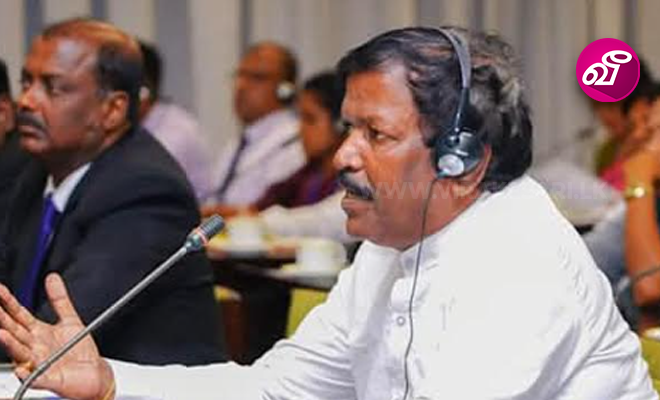
முல்லைத்தீவு - கொழும்பிற்கான குளிரூட்டப்பட சொகுசுப் பேருந்துசேவை எப்போது ஆரம்பிக்கப்படுமென வன்னிமாவட்ட நாடாளுமன்ற உறுப்பினர் துரைராசா ரவிகரன் போக்குவரத்து, நெடுஞ்சாலைகள், துறைமுகங்கள் மற்றும் சிவில் விமான சேவைகள் அமைச்சர் விமல் ரத்நாயக்கவிடம் கேள்வி எழுப்பியுள்ளார்.
இந்நிலையில் குறித்த முல்லைத்தீவு கொழும்பிற்கான குளிரூட்டப்பட்ட சொகுசுப் பேருந்து சேவையானது இம்மாதத்திற்குள் விரைவாக ஆரம்பிக்கப்படுமென அமைச்சின் அதிகாரிகளால் பதில் வழங்கப்பட்டுள்ளது.
நாடாளுமன்றில் வியாழக்கிழமை (09) இடம்பெற்ற போக்குவரத்து, நெடுஞ்சாலைகள், துறைமுகங்கள் மற்றும் சிவில் விமான சேவைகள் அமைச்சின் ஆலோசனைக்குழுக்கூட்டத்திலேயே இவ்விடயம் தொடர்பில் பேசப்பட்டுள்ளது.
இதன்போது நாடாளுமன்ற உறுப்பினர் ரவிகரன் மேலும் கருத்துத் தெரிவிக்கையில்,
முல்லைத்தீவு கொழும்பிற்கான குளிரூட்டப்பட்ட சொகுசுப்பேருந்து சேவை இதுவரை இல்லாத நிலை காணப்படுகின்றது. எனவே இந்த குளிரூட்டப்பட்ட சொகுசுப் பேரூந்துசேவை ஆரம்பிக்கப்படவேண்டும்.
இதற்கு முன்பும் இரண்டுதடவைகள் இந்த போக்குவரத்து, நெடுஞ்சாலைகள், துறைமுகங்கள் மற்றும் சிவில் விமான சேவைகள் அமைச்சின் ஆலோசனைக்குழுக்கூட்டத்தில் இந்த முல்லைத்தீவு கொழும்பிற்கான சொகுசுப்பேருந்து சேவைதொடர்பில் பேசியிருந்தேன். விரைந்து இச் சேவையை ஆரம்பிக்குமாறும் கோரியிருந்தேன்.
அதற்கான பதில்கள் கிடைக்குமென எதிர்பார்கின்றேன். தயவுசெய்து இந்த சொகுசுப் பேருந்துசேவையினை விரைந்து ஆரம்பிக்குமாறு வலியுறுத்திக் கேட்டுக்கொள்கின்றேன் - என்றார்.
இந்நிலையில் இதற்கு அமைச்சின் அதிகாரிகள் பதிலளிக்கையில்,
கூடியவிரைவில் இந்த பேருந்து சேவையை ஆரம்பிப்பதற்கு திட்டமிட்டுள்ளோம். அந்தவகையில் எதிர்வரும் 15ஆம் திகதி போக்குவரத்து, நெடுஞ்சாலைகள், துறைமுகங்கள் மற்றும் சிவில் விமான சேவைகள் அமைச்சுசார்ந்த கூட்டமொன்று இடம்பெறும். அக்கூட்டத்தில் இந்த சொகுசுப் பேருந்து சேவையினை ஆரம்பிப்பது தொடர்பான விடயங்கள் தொடர்பான விடயங்கள் தொடர்பில் ஆராயப்படும்.
அந்தவகையில் இம்மாத இறுதிப்பகுதிக்குள் இந்த பேருந்து சேவை ஆரம்பிக்கப்படுமெனத் தெரிவிக்கப்பட்டது.
இந்நிலையில் நாடாளுமன்ற உறுப்பினர் ரவிகரனால் இதன்போது அமைச்சர் விமல் ரத்நாயக்கவிற்கு நன்றி தெரிவிக்கப்பட்டமையும் குறிப்பிடத்தக்கது.
முல்லைத்தீவிற்கான சொகுசுப்பேருந்துசேவை தொடர்பில் கேள்வி எழுப்பிய ரவிகரன் எம்.பி; இம்மாதத்திற்குள் ஆரம்பிக்கப்படும் - அமைச்சின் அதிகாரிகள் பதில் | Virakesari.lk
கருத்து படங்கள்
காஸாவில் 2 ஆண்டுகளுக்குப் பிறகு அமைதி – மக்களின் கொண்டாட்டத்தை காட்டும் 10 படங்கள்
காஸாவில் 2 ஆண்டுகளுக்குப் பிறகு அமைதி – மக்களின் கொண்டாட்டத்தை காட்டும் 10 படங்கள்
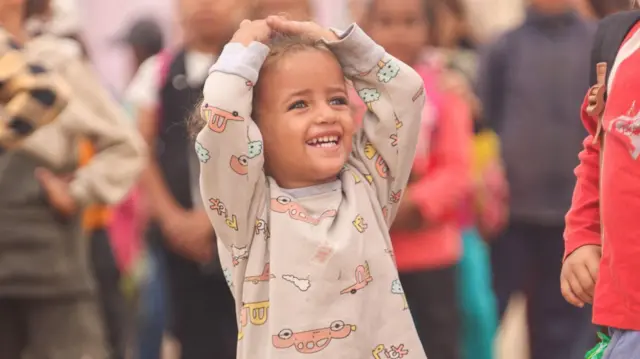
பட மூலாதாரம், Getty Images
படக்குறிப்பு, காஸா அமைதி திட்டத்துக்கு இஸ்ரேலும் ஹமாஸும் ஒப்புக்கொண்டது.
ஒரு மணி நேரத்துக்கு முன்னர்
காஸா போர் நிறுத்த ஒப்பந்தத்தின் முதல் கட்டத்துக்கு இஸ்ரேலும் ஹமாஸும் ஒப்புக்கொண்டுள்ளன.
காஸாவில் இரண்டு ஆண்டுகளாக தொடரும் போரை முடிவுக்கு கொண்டுவருவதற்கான முக்கிய நகர்வாக இது பார்க்கப்படுகிறது.

பட மூலாதாரம், Getty Images
இந்த முதற்கட்ட போர் நிறுத்தம் மூலம் பணயக்கைதிகள் அனைவரும் விடுவிக்கப்படுவார்கள் எனவும், இஸ்ரேல் தங்கள் துருப்புக்களை ஒப்புக்கொண்ட எல்லை வரை திரும்பப் பெறும் என்றும் டொனால்ட் டிரம்ப் தனது ட்ரூத் சோஷியல் பக்கத்தில் தெரிவித்துள்ளார்.
போர் நிறுத்தம் பற்றிய செய்திகள் வெளியானதை அடுத்து காஸாவிலும் இஸ்ரேலிலும் மக்கள் ஒன்றுகூடி கொண்டாடினர்.
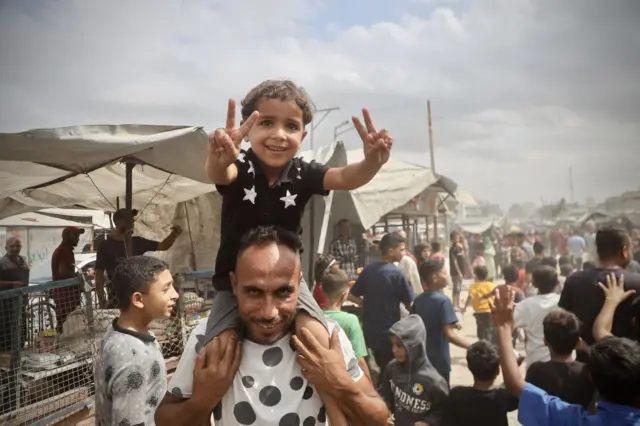
பட மூலாதாரம், Getty Images
படக்குறிப்பு, காஸாவில் இருந்து இஸ்ரேலிய படைகள் திரும்பப் பெறப்படுகிறது.
அமெரிக்க அதிபர் டொனால்ட் டிரம்ப் முன்மொழிந்த ஒப்பந்தத்தின் முதல் கட்டத்தை ஏற்றுக்கொண்ட இஸ்ரேல், காஸாவின் சில பகுதிகளில் இருந்து இஸ்ரேலிய படைகளை திரும்பப் பெறத் தொடங்கியுள்ளது.
ஒப்புதல் அளிக்கப்பட்ட 24 மணி நேரத்திற்குள் இஸ்ரேலிய படைகள் பின்வாங்க வேண்டும்.
அதன்பிறகு, ஹமாஸ் தங்களிடம் உள்ள பணயக்கைதிகளை விடுவிக்க வேண்டிய 72 மணி நேர நிபந்தனை நேரம் தொடங்கும்.
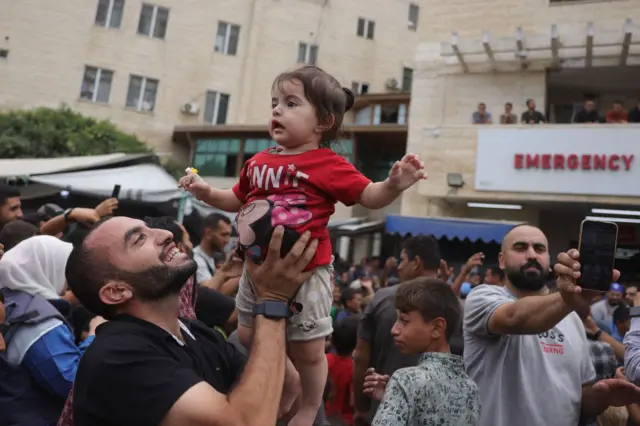
பட மூலாதாரம், Getty Images
படக்குறிப்பு, பணயக்கைதிகளை விடுவிக்க 72 மணி நேரம் அவகாசம்.
அக்டோபர் 7 தாக்குதலுக்குப் பிறகு காஸா மீது இஸ்ரேல் ராணுவ நடவடிக்கையை தொடங்கியது. ஹமாஸ் நடத்திய தாக்குதலில் 1,200 இஸ்ரேலியர்கள் கொல்லப்பட்டனர், 251 பேர் பணயக்கைதிகளாக ஹமாஸால் பிடித்துச் செல்லப்பட்டனர்.
பதிலுக்கு காஸாவில் இஸ்ரேல் தொடங்கிய போரில், இதுவரை 67,100-க்கும் மேற்பட்டோர் கொல்லப்பட்டுள்ளனர்.

பட மூலாதாரம், Getty Images
படக்குறிப்பு, இஸ்ரேல் நடத்திய தாக்குதலில் 67,100-க்கும் மேற்பட்டோர் கொல்லப்பட்டுள்ளனர்.
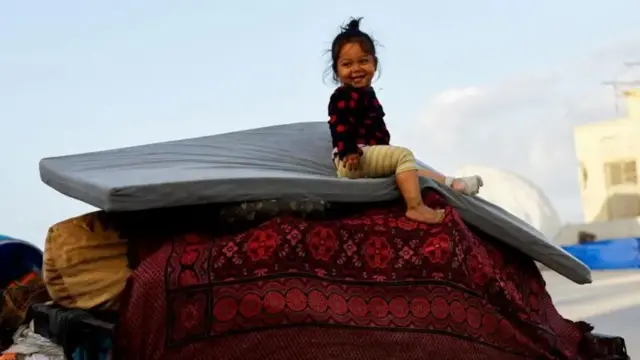
பட மூலாதாரம், Reuters
காஸா போர் நிறுத்த ஒப்பந்தத்தின் முதற்கட்டம் நிறைவேற்றப்பட்ட பிறகு, அடுத்த கட்டங்களின் விவரம் பற்றி பேச்சுவார்த்தை நடத்தப்படும். ஆனால், அது தொடர்பான உடன்பாட்டை எட்டுவது கடினமாக இருக்கலாம்.

பட மூலாதாரம், Getty Images
படக்குறிப்பு, இரு தரப்பினரும் ஒப்புக்கொண்ட பின், போர் உடனடியாக முடிவுக்கு வரும்
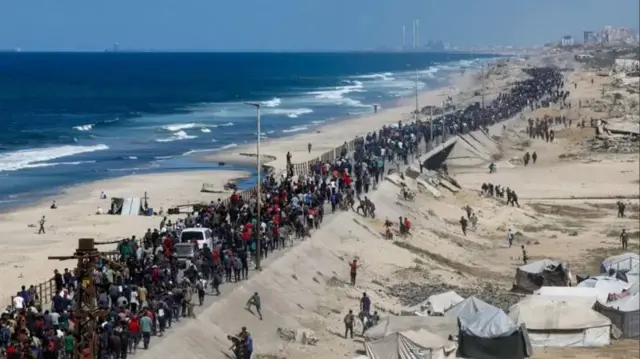
பட மூலாதாரம், Reuters
டிரம்ப் முன்மொழிந்த 20 அம்ச காஸா போர் நிறுத்த ஒப்பந்தத்தின்படி நிபுணர்கள் கொண்ட டிரம்ப் தலைமையிலான குழு தற்காலிகமாக காஸாவில் நிர்வகத்தை கவனித்துக்கொள்ளும். முன்னாள் பிரிட்டன் பிரதமர் சர் டோனி பிளேர் பிற தலைவர்களுடன் சேர்ந்து இந்த ஆட்சிக் குழுவில் ஒரு பகுதியாக இருப்பார்.
பின்னர், காஸாவின் நிர்வாகம் பாலத்தீன அதிகார சபைக்கு மாற்றப்படும். டிரம்பின் திட்டப்படி, எதிர்காலத்தில் ஹமாஸ் காஸாவின் நிர்வாகத்தில் நேரடியாகவோ, மறைமுகமாகவோ பங்கேற்க முடியாது.
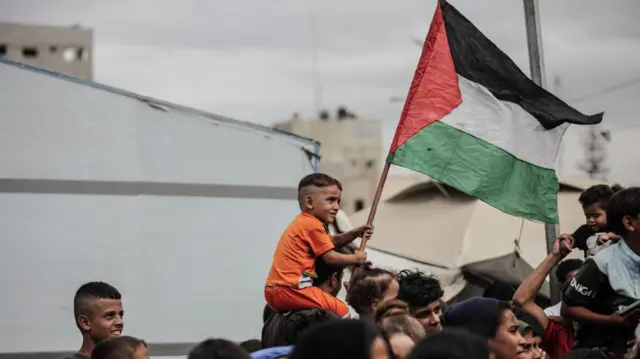
பட மூலாதாரம், Getty Images
மற்றொரு முக்கிய விஷயமாக இஸ்ரேலிய ராணுவத்தை பின்வாங்குவது உள்ளது. முதற்கட்டமாக காஸாவின் 53 சதவீத பகுதியை இஸ்ரேல் தனது கட்டுப்பாட்டில் வைத்திருக்கும் என வெள்ளைமாளிகையின் திட்டம் கூறுகிறது.
பின்னர் இது அடுத்த கட்டங்களில் 40 சதவீதம் மற்றும் 20 சதவீதமாக பின்வாங்கப்படும் எனவும் அதில் குறிப்பிடப்பட்டுள்ளது.
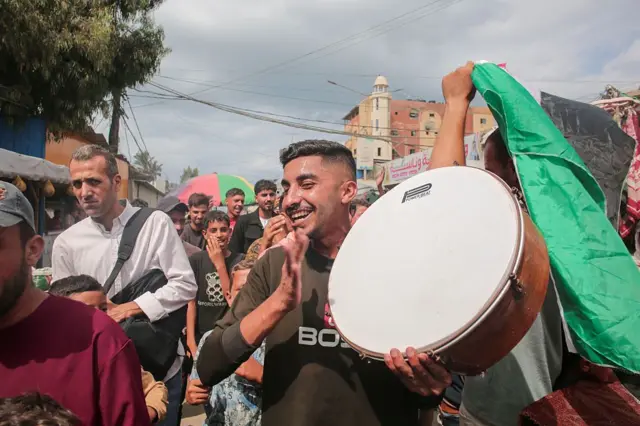
பட மூலாதாரம், Getty Images
படக்குறிப்பு, முதற்கட்டமாக காஸாவின் 53 சதவீத பகுதியை இஸ்ரேல் தனது கட்டுப்பாட்டில் வைத்திருக்கும்
இதில் இந்தப் படைகள் பின்வாங்குவது பற்றி தெளிவான காலக்கெடுவை இந்தத் திட்டம் வழங்கவில்லை. இது தெளிவுபடுத்த வேண்டுமென ஹமாஸ் விரும்புகிறது.
- இது, பிபிசிக்காக கலெக்டிவ் நியூஸ்ரூம் வெளியீடு
வட மாகாண ஆளுநர் கழிவு மின் உற்பத்தி திட்டம் குறித்து அறிவுறுத்தல்
வட மாகாண ஆளுநர் கழிவு மின் உற்பத்தி திட்டம் குறித்து அறிவுறுத்தல்
(எம்.நியூட்டன்)
வடக்கில் குறிப்பாக யாழ்ப்பாணத்தில் கழிவகற்றல் பெரும் சவாலாக உருவாகியிருப்பதால் கொழும்பு மாநகர சபையால் கழிவுபொருட்களிலிருந்து மின்சாரம் உருவாக்கும் மின் உற்பத்தி நிலையங்களை பார்வையிட்டு அத்தகைய திட்டங்களின் சாத்தியபாடுகளை ஆராயுமாறு வடக்கு மாகாண ஆளுநர் நாகலிங்கம் வேதநாயகன் ஆளுநர் பணிப்புரை விடுத்துள்ளார்.
வடக்கு மாகாண உள்ளூராட்சி மன்றங்களின் செயலாளர்களுடனான மாதாந்தக் கலந்துரையாடல் வெள்ளிக்கிழமை (10) ஆளுநர் செயலகத்தில் நடைபெற்றது இதன்போதே அவர் இதனை தெரிவித்தார்.
மேலும் தெரிவிக்கையில் யாழ்ப்பாணத்தில் கழிவகற்றல் தொடர்பான விவகாரம் மிகப் பெரும் சவாலாக உருவாகிவரும் நிலையில் கொழும்பு மாநகர சபையால் கழிவுப் பொருட்களிலிருந்து மின்சாரம் உருவாக்கும் மின்உற்பத்தி நிலையங்கள் உருவாக்கப்பட்டுள்ள நிலையில் அவற்றைப் பார்வையிட்டு அத்தகையை திட்டத்தை முன்னெடுப்பதற்கான சாத்தியப்பாடுகளை ஆராயுமாறும் வலியுறுத்தியுள்ளார்.
இதேவேளை, உள்ளூராட்சி மன்றங்கள் தமது எல்லைக்குட்பட்ட பகுதிகளில் குப்பைகள் போடுவதைக் கண்காணிக்கும் வகையில் சிசிரிவி கமராக்களைப் பொருத்துவதற்கு நடவடிக்கை எடுக்குமாறும் உள்ளூராட்சி மன்ற செயலாளர்களை கேட்டுக்கொண்டார்.
வட மாகாண ஆளுநர் கழிவு மின் உற்பத்தி திட்டம் குறித்து அறிவுறுத்தல் | Virakesari.lk

